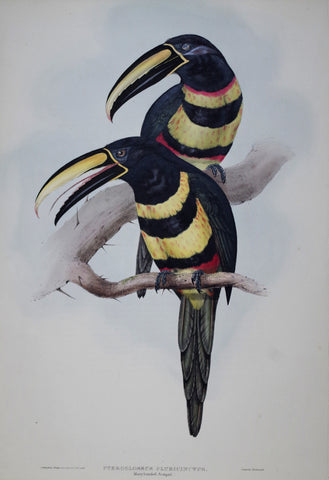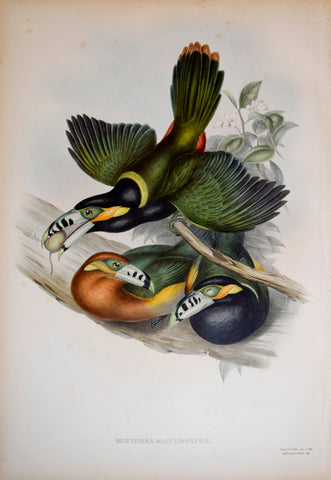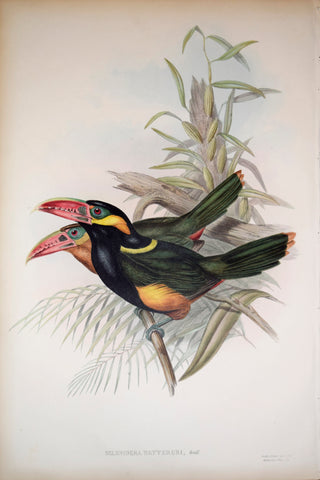Search By Artist
John Gould (1804-1881), Toucans
A Monograph of the Ramphastidae, or Family of Toucans.
London: Taylor and Francis for the author, 1833-1835 (first edition), 1852-1854 (second edition)
Lithographs with original hand-coloring.
Originally issued in three parts in 1833, 1834 and 1835. the second edition contains 18 new plates, not included In the first edition, of the magnificent toucan family, found in Mexico, Central and South America and some West Indian islands. Lear's remarkable images of of the birds fill the plate, showing young birds with the fully grown, and are regarded as among the best of his zoological drawings; the uncoloured plate accompanies Richard Owen's final chapter on the anatomy of the toucan, written especially for the work.
Edward Lear is fondly remembered for his books of nonsense and for popularizing the limerick, but he was also a prolific watercolourist, who as a young man earned his livelihood and achieved recognition as an illustrator of birds and animals. Born in the north London suburb of Holloway on 12 May 1812, he was the youngest of twenty-one children born to Jeremiah and Ann Lear. His childhood was one of outward prosperity but in 1825, his father, a stockbroker, was ruined by a financial crisis brought on by unfortunate speculation, and consigned to the debtor's prison. At the age of fifteen the young and somewhat sickly Edward had to start earning his own living. Initially, he tinted drawings of birds for shops and printsellers, also doing work for various hospitals and medical men - "I began to draw for bread and cheese about 1827," he wrote "but only did uncommon queer shop-sketches - selling them for prices varying from ninepence to four shillings; coloring prints, screens and fans; awhile making morbid disease drawings, for hospitals and certain doctors of physic." This training suited him well and at an early age he was already taking pupils of his own. In 1830, at the age of 18, Lear obtained permission to work as a draughtsman at the Zoological Society gardens, located at Regent's Park. The following year he moved with his sister, Ann, to nearby lodgings in Albany Street, in order to be close to his work and during the course of the next two years devoted his time to recording the different members of the parrot family. He was encouraged in this task by N. A. Vigors, John Gould and Lord Stanley and between 1830 and 1832 "Illustrations of the Family Psittacidae, or Parrots" was published in parts.
Gould was initially employed as a taxidermist [he was known as the 'bird-stuffer'] by the Zoological Society, and his fascination with birds began in the "late 1820s [when] a collection of birds from the Himalayan mountains arrived at the Society's museum and Gould conceived the idea of publishing a volume of imperial folio sized hand-coloured lithographs of the eighty species, with figures of a hundred birds (A Century of Birds Hitherto Unfigured from the Himalaya Mountains, 1830-32). Gould's friend and mentor N. A. Vigors supplied the text. Elizabeth Gould made the drawings and transferred them to the large lithographic stones.
Having failed to find a publisher, Gould undertook to publish the work himself; it appeared in twenty monthly parts, four plates to a part, and was completed ahead of schedule. "With this volume Gould initiated a format of publishing that he was to continue for the next fifty years, although for future works he was to write his own text. Eventually fifty imperial folio volumes were published on the birds of the world, except Africa, and on the mammals of Australia-he always had a number of works in progress at the same time. Several smaller volumes, the majority not illustrated, were published, and he also presented more than 300 scientific papers. "His hand-coloured lithographic plates, more than 3300 in total, are called 'Gould plates'. Although he did not paint the final illustrations, this description is largely correct: he was the collector (especially in Australia) or purchaser of the specimens, the taxonomist, the publisher, the agent, and the distributor of the parts or volumes. He never claimed he was the artist for these plates, but repeatedly wrote of the 'rough sketches' he made from which, with reference to the specimens, his artists painted the finished drawings. The design and natural arrangement of the birds on the plates was due to the genius of John Gould, and a Gould plate has a distinctive beauty and quality. His wife was his first artist. She was followed by Edward Lear, Henry Constantine Richter, William Matthew Hart, and Joseph Wolf" (Gordon C. Sauer for DNB).
Anker 170; "Fine Bird Books" (1990) p. 101; Nissen 378; Sauer 19; Wood p. 365; Zimmer, p. 259.







